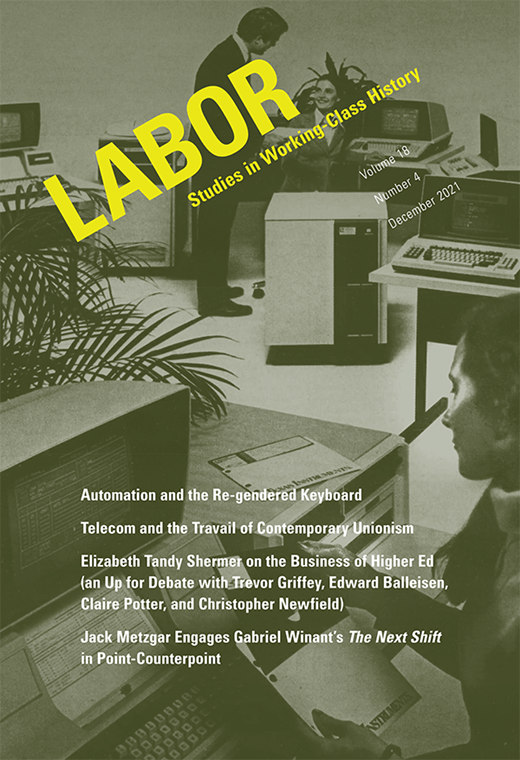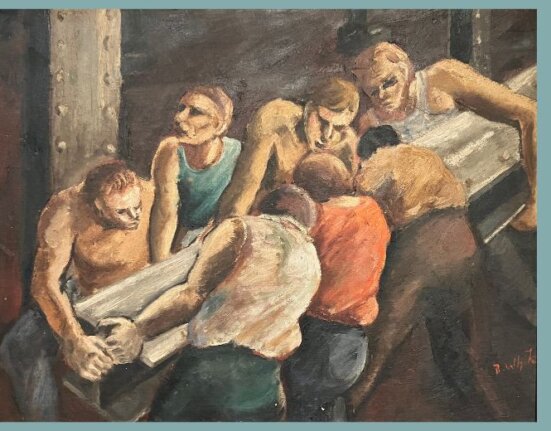Jason Resnikoff’s essay The Paradox of Automation: QWERTY and the Neuter Keyboard is now available with free access until March 31, 2022 of Labor: Working Class Studies of the Americas. The essay gives new perspectives on how typing, considered one of the “office wife” service duties, became “neutered,” in the late twentieth century. I asked him to highlight a few aspects of his research and perspective.
- How does your essay apply a labor and gender lens to understand the way that typing became “neutered” from its previous association with degraded low-paid female labor often associated with the “office wife” concept. Tell us a few highlights.
There is simply no way to make sense of the QWERTY keyboard’s sudden and dramatic gender change in the 1980s other than through the lenses of gender and labor. And the swiftness of that change is really quite remarkable when you consider the ubiquity of the gender-neutral alphanumeric keyboard today. I imagine that most people under 65 would be simply flummoxed if they heard it said that only “girls” should type, even though for most of the twentieth century such an utterance was practically a truism in American offices. But while one might think that typing became gender-neutral simply through the broad diffusion of computers around the turn of the twenty-first century, that is actually not the case. The main innovation in this story was not technological, but political. Specifically, the women’s movement of the late 1960s and 1970s.

Employers had tried for years to convince mid-level managers to take on clerical duties, but the gendered hierarchies of labor in the office had made it nearly impossible to persuade male managers that they would not be endangering their masculinity if they typed for themselves. Well into the last quarter of the twentieth century, male managers understood female clerical workers (and most clerical workers at the time were women) as maids of all work. They typed and filed, yes, but they also were expected to make coffee, fetch lunch, perform housekeeping tasks, and serve as sex objects. The job of clerical worker was in the final instance a performance of servility, to play the part of what was generally known as the “office wife.”
This changed with the women’s movement. Female office workers organized to end sexist practices and exclusions in the workplace. They agitated for unions, for managerial positions, and for an end to sexual harassment. This worker activism did much to change the culture of the American office, although of course gender parity remains elusive now, fifty years later. Significantly, women activists abolished the role of “office wife.” Ironically, this had been the major impediment blocking employers from forcing male managers to do their own clerical tasks. Because activists in the women’s movement had already undermined key pillars of the sexist hierarchy of the office, it opened a space for employers to begin degrading the managerial positions to which a new generation of women had just gained some limited access. The vehicle for this change was the desktop computer; the masculine allure of computers served to compensate for QWERTY’s femininity. But really, none of those attempts could have borne fruit had managers not already been forced to give up at least superficially on the “office wife.” In this new world, employers used the promise of automation and computers to liberate managers from what one boss called “the tyranny of the secretary.” One can imagine how a male manager might want to be free of a worker who now was both organized, and who might well refuse to accept the sexist norms of the old office.
The irony of all this is that the apparent technological innovation on which everyone focused at the time—the desktop computer—was really an afterthought in all this. The newfangled “microcomputer” was really just a spectacular vehicle (a Trojan horse, if you will) that conveyed into the mid-level managers’ ranks the same old managerial desire to cut costs by degrading labor. And it also distracted from the real revolution that made all this possible, women’s liberation.
- What do you mean by “the paradox of automation” in the title?
In theory, the word “automation” is supposed to mean the elimination of human labor. Yet in researching its historical origins and subsequent career, I’ve found that time and again the technological changes that managers and even workers call “automation” resulted not in the elimination of human labor, but rather its intensification, and on occasion an increase in the number of people hired to do a supposedly ‘automated’ job. More impressive to me has been the discovery that sometimes even workers credit machines with doing the extra work that they themselves are now being compelled to do.
This last tendency was certainly the case with the re-gendering of the QWERTY keyboard at the end of the twentieth century. But the paradox goes far beyond QWERTY. To put it as a question, one might ask, ‘How could workers come to see being compelled to work more as needing to work less?’ That’s the paradox. The answer is complicated. Some historians of the past (and a few in the present) would slap the label ‘false consciousness’ on the problem and leave it at that. I for one don’t find that explanation completely satisfying, although I think it points to something true: the power of ideology to shape our perceptions of material reality. Office employers were able to convince male managers to use alphanumeric keyboards—a tool and a task that before a male manager would have seen as an unacceptably feminine—because they were able to play on managers’ deeply held beliefs about masculinity and technological progress. In addition to their ability to physically act upon matter in a useful way, machines are often just as important for their role as spectacle. Similar to the automata of the early modern period, machines in our own time are built to astound, to invoke feelings of wonder and to intimidate. That spectacle, just as much as any intrinsic ability of the machine to do anything on its own, serves a vital function. In the case of the desktop computer in the 1980s, it served to transmute a speedup of labor into a sense on the part of workers that they were participating in progress itself. Typing no longer seemed degrading to these men because whereas before it had actuated the clerk’s typewriter, now it operated a powerful, state-of-the-art mechanism, the desk top computer. And as they did this work, many mid-level managers believed that they were in fact being freed from it. The paradox persists in our moment. Today, technological innovations like work-tracking apps, smart phones, and virtual meeting spaces—just to name a few—are often sold to workers as great innovations in convenience, while in reality they mostly serve to surveil workers, regiment them, speed them up, and extract more value from them. In other words, the paradox of automation is actually one way in which working people experience the larger contradictions of so-called ‘technological progress’ writ large. Society gains more technical power and capital promises a brighter, technologically-produced future, but exploitation, hierarchy, and regimentation remain. It falls to the world of ideology both to express and to bridge this disconnect. Historically, the automation discourse has performed that service.
- You have some great images in this essay! Highlight one, and tell me why you find it compelling. (Are there any that you left out that you’d like to share?)

This is hard. One of the great pleasures of writing this article was leafing through old issues of computer trade journals and swimming in the visual world of 1980s computing. So I think I’ll highlight two. I continue to be impressed by an advertisement for optical scanners by the Caere Corporation (figure 8) that shows, simply, a pair of women’s hands that it then denigrates as “10 reasons why you’re losing speed and accuracy in data entry.” This hostility to the human form is usually subtext in the history of industrial laboring, not literal text. There is a tradition among anthropologists of claiming that the human hand allowed the species to develop itself, its built world, its consciousness. The hand is such a loaded, meaningful organ, so to have it demeaned explicitly as an impediment really took my breath away; it was so obviously misanthropic.

I also really do love the image of the Microwriter that serves as figure 1 in the article. I had never heard of the Microwriter before I began research. I learned of it from an advertisement in an old edition of the Wall Street Journal. When I found it’s user manual online, that’s when I knew that I could really write this article. It’s such a strange, sensuous device. The machine looks almost organic: sleek, bulbous, but also clunky. The Microwriter was meant as an alternative to the alphanumeric computer. In the late 1970s and 1980s, employers and computer-makers were looking for ways to convince men to use what was still a degraded, feminine apparatus, the QWERTY keyboard. Of course, in the end employers and advertisers simply re-gendered the old alphanumeric keyboard, but at least one manufacturer thought it would be easier to convince men to type if they did it using an entirely different device. Thus, the Microwriter. The developer made it portable and gave it chording keys so that it would feel wholly different from a traditional keyboard. They claimed that the operator did not type with it, they instead wrote “into type,” as though the typist had been automated away, while, in fact, now the operator of the Microwriter was now doing the typing. This picture is delightful because in it you have an artefact capturing a specific historical moment.
- How is this essay connected to your findings in your new book on automation?
Although much of the material in this article does not actually appear in my book, Labor’s End, in many ways the article is a case study of the more general phenomenon of the automation discourse that the book investigates (the article is less a digest of the book, and more a spin off). Looking at the historical origins of automation in the postwar period—the word was officially coined by the Ford Motor Company in 1947—the book shows how early examples of what was called automation did not eliminate human labor. “Automation” was not primarily a technological innovation. Rather, it was an ideological phenomenon—there was no major material distinction to be made between what contemporaries called “automation” and what earlier generations had known as mechanization or, more generally, industrialization. In automobile manufacturing, meatpacking, coal mining, dock work, rail freight, as well as office work and domestic labor, the big promises of the automation discourse obscured a tendency on the part of employers to degrade and speed up human labor. Where firms were able to lay off workers, for the most part the newly unemployed were not replaced by robots; they were replaced by other workers, now working harder and under worse conditions than before. The question I ask in the book is rather similar to the one posed in this article: how did people across the political spectrum come to see the material degradation of human labor as its opposite, as progress? Where this article only has space to hint at the ideological props holding up the automation discourse, the book focuses on how and why so many in the postwar period came to believe that, in principle, freedom and work were mutually exclusive, and why it made sense to them—and with dire consequences for future generations of workers—to abandon the workplace as a site of political contest.
Jason Resnikoff is a Core Lecturer in the History Department at Columbia University. He specializes in labor history, the history of global capitalism, intellectual history, and the history of technology. His forthcoming book, Labor’s End: How the Promise of Automation Degraded Work, explores the ideological origins of automation in the US in the middle of the twentieth century. His work has appeared in Labor, International Labor and Working-Class History, Tropics of Meta, Western Humanities Review, Paris Review, and the Encyclopedia of American Recessions and Depressions. Formerly an organizer for the United Auto Workers, he is affiliated with Columbia University’s American Studies Department, where he advises undergraduate senior theses, as well as Columbia’s Justice in Education initiative, through which he teaches incarcerated students.






